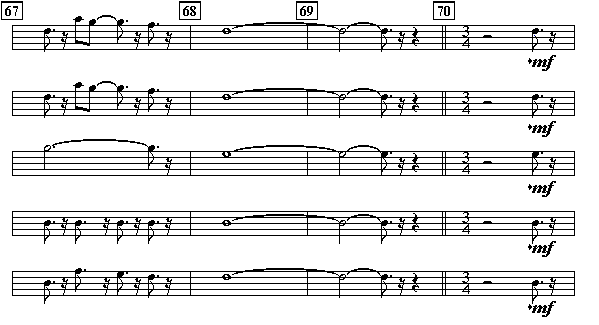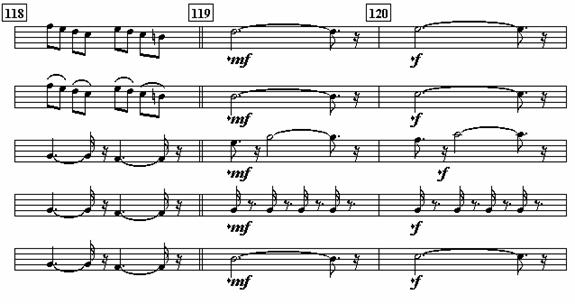Section 5: Working Examples
One of the most effective ways to learn site reading is to decompile a score and pin-point all of the elements. Now that you have reviewed the terms and definitions, it is time to put knowledge to application.
There is no greater teaching tool than experience. With that being said, these working examples are designed specifically to exercise the concepts and theory you have learned, and turn them into "real world" experience.
After each excerpt you will be given a pop quiz to test your knowledge. You should be able to answer every question here using information from this book.
After you have completed each pop quiz, the correct answers can be found in Appendix of Answers. To be fair to yourself, please complete the pop quizzes before you view the answers in the back of this book.
Example 1: (Excerpt #1 from Serenade the Wolves by Dexter Nelson).

Pop Quiz:
Take out a pen and paper and answer the following:
- Identify and name the clefs of the five staves.
- What is the name of the accidental at the beginning of the staves?
- Using the name of the accidental, identify the key the composition it is written in.
- Yes or No: Are there any other accidentals used in the excerpt?
- How many measures are in this excerpt?
- What is the time signature of the composition?
- What is the name of the first note on each staff?
- The smallest note duration in this excerpt is a sixteenth note.
- True
- False
- The largest note duration in this excerpt is a whole note.
- True
- False
- The smallest rest duration in this excerpt is an eighth rest.
- True
- False
- The largest rest duration in this excerpt is a sixteenth rest.
- True
- False
- What is the duration of the dotted-quarter note in measure two of the bottom staff?
- 1 1/2 beats
- 2 beats
- 1 3/4 beats
- 2 1/2 beats
- None of the above
- Looking at the time signature of the excerpt, how many beats per measure are there?
- 8
- 16
- 4
- 2
- Looking at the time signature of the excerpt, a dotted half note would carry:
- 2 3/4 beats
- 3 beats
- 2 1/2 beats
- 1 3/4 beats
- None of the above
- What is the tempo of this excerpt?
Example 2: (Excerpt #2 from Serenade the Wolves by Dexter Nelson).

Pop Quiz:
Take out a pen and paper and answer the following:
- In measure 70, there is a change in the time signature from 4/4-time to 3/4-time. How many beats per measure after measure 70 are there?
- 4
- 3
- 2
- 1
- What is the key signature of measure 70?
- What is the duration of the note whole note in measure 68 of the top Treble staff?
- What is the largest rest duration in this excerpt?
- What is the shortest note duration in this excerpt?
- What des the dynamic, (*mf), represent in measure 70?
- In measure 70, what is the duration of the rest on each staff?
- Identify the first note of measure 67 on each staff.
- What does the double bar in front of signify?
- At the end of measure 69, there are two rests. What is the duration of the combined rests?
- In measures 68 and 69, the three notes are tied. What is the duration of the combined notes?
- On the two bass staves, what is the duration of each note?
- On the two bass staves, what is the duration of each rest?
- On the two Treble staves, what is the duration of the tied eighth note and the dotted quarter note?
- What is the duration of the dotted quarter note in measure 70?
Example 3: (Excerpt #3 from Serenade the Wolves by Dexter Nelson).

Pop Quiz:
Take out a pen and paper and answer the following:
Given: The time signature of the excerpt is 4/4
- What is the smallest note duration in the excerpt?
- What is the longest rest duration in the excerpt?
- What does the accidental at the end of measure 118 signify on the second Treble staff?
- What is the pitch of the note on the second Treble staff?
- Define the dynamic, (*f) in measure 120.
- On the two bass staves, what is the duration of the dotted quarter note and the sixteenth note?
- If you were to place a dynamic variance between measures 119 and 120, what variance would you use to describe the shift from *mf to *f?
- How many measures are there in the excerpt?